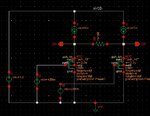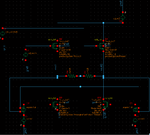fogandflower
Newbie level 5
Hi, I have a very simple circuit use pmos source follower as output buffer. The output load is 100ohm resister. The source follower gate voltage difference should define the current go through the load resistor. Design current is 1mA, and expected 100mV single-ended output. However, the test results only showed 50mv output range. I tried a lot simulation condition and could not repeat the test results (always 100mv output). May i know why this happened? What is the root cause?





